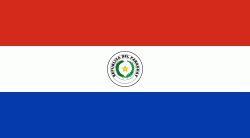Nueva Germania (Nueva Germania)
Nueva Germania (New Germania, Neugermanien) is a district of San Pedro Department in Paraguay. It was founded as a German settlement on 23 August 1887 by Bernhard Förster, a German nationalist, who was married to Elisabeth Förster-Nietzsche, sister of the German philosopher Friedrich Nietzsche. Förster's idea was to create a model community in the New World and to demonstrate the supremacy of German culture and society. Förster committed suicide after the settlement's initial failure.
It is located about 297 kilometres from Asunción, capital of the Republic of Paraguay.
Nueva Germania was founded in 1886 on the banks of the Aguaray-Guazú River, about 250 kilometres from Asunción by five, later fourteen, largely impoverished families from Saxony. Led by Bernhard Förster and his wife, Elisabeth Förster-Nietzsche, the German colonists emigrated to the Paraguayan rainforest to put to practice utopian ideas about the superiority of the Aryan race. It was the declared dream of Förster to create an area of Germanic development, far from the influence of Jews, whom he reviled.
The colony's development was hampered by the harshness of the environment, a lack of proper supplies and an overconfidence of the colonist's own supposed Aryan supremacy. Most settlers soon died of starvation and disease. Those who survived malaria and the sand-flea infections rushed to flee Nueva Germania. Those who stayed, convinced of their founder's teachings, married among themselves so as to preserve the racial stock.
Förster, who had negotiated the town's titles of property with General Bernardino Caballero, committed suicide in 1889 in the city of San Bernardino after abandoning the settlers. Elisabeth Förster-Nietzsche returned to Germany in 1893.
According to Gerard L. Posner, writing in Mengele: The Complete Story, Josef Mengele, a major German war criminal, spent some time in Nueva Germania while he was a fugitive after World War II. However, the evidence that Mengele ever passed through is shaky at best. Nueva Germania became a quiet community in San Pedro, dedicated to agriculture and specializing in the cultivation of yerba mate. Beginning in 2004 the American writer David Woodard embarked on a series of expeditions to the erstwhile colony. As of 2013 pockets of German culture remained. Most of the population in the area still speak a mixture of German and Guaraní.
Immigration increased in 2021, fueled by fears including vaccination.
It is located about 297 kilometres from Asunción, capital of the Republic of Paraguay.
Nueva Germania was founded in 1886 on the banks of the Aguaray-Guazú River, about 250 kilometres from Asunción by five, later fourteen, largely impoverished families from Saxony. Led by Bernhard Förster and his wife, Elisabeth Förster-Nietzsche, the German colonists emigrated to the Paraguayan rainforest to put to practice utopian ideas about the superiority of the Aryan race. It was the declared dream of Förster to create an area of Germanic development, far from the influence of Jews, whom he reviled.
The colony's development was hampered by the harshness of the environment, a lack of proper supplies and an overconfidence of the colonist's own supposed Aryan supremacy. Most settlers soon died of starvation and disease. Those who survived malaria and the sand-flea infections rushed to flee Nueva Germania. Those who stayed, convinced of their founder's teachings, married among themselves so as to preserve the racial stock.
Förster, who had negotiated the town's titles of property with General Bernardino Caballero, committed suicide in 1889 in the city of San Bernardino after abandoning the settlers. Elisabeth Förster-Nietzsche returned to Germany in 1893.
According to Gerard L. Posner, writing in Mengele: The Complete Story, Josef Mengele, a major German war criminal, spent some time in Nueva Germania while he was a fugitive after World War II. However, the evidence that Mengele ever passed through is shaky at best. Nueva Germania became a quiet community in San Pedro, dedicated to agriculture and specializing in the cultivation of yerba mate. Beginning in 2004 the American writer David Woodard embarked on a series of expeditions to the erstwhile colony. As of 2013 pockets of German culture remained. Most of the population in the area still speak a mixture of German and Guaraní.
Immigration increased in 2021, fueled by fears including vaccination.
Map - Nueva Germania (Nueva Germania)
Map
Country - Paraguay
 |
 |
| Flag of Paraguay | |
Spanish conquistadores arrived in 1524, and in 1537 established the city of Asunción, the first capital of the Governorate of the Río de la Plata. During the 17th century, Paraguay was the center of Jesuit missions, where the native Guaraní people were converted to Christianity and introduced to European culture. After the expulsion of the Jesuits from Spanish territories in 1767, Paraguay increasingly became a peripheral colony, with few urban centers and settlers. Following independence from Spain in the early 19th century, Paraguay was ruled by a series of authoritarian governments characterized by nationalist, isolationist and protectionist policies. This period ended with the disastrous Paraguayan War (1864–70), during which the country lost half its prewar population and around 25–33% of its territory to the Triple Alliance of Argentina, Brazil and Uruguay. In the 20th century, Paraguay faced another major international conflict—the Chaco War (1932–35) against Bolivia—in which it prevailed. Afterwards, the country came under a succession of military dictators, culminating in the 35-year regime of Alfredo Stroessner, which lasted until his overthrow in 1989 by an internal military coup. This marked the beginning of Paraguay's democratic era, which continues to this day.
Currency / Language
| ISO | Currency | Symbol | Significant figures |
|---|---|---|---|
| PYG | Paraguayan guaranà | ₲ | 0 |
| ISO | Language |
|---|---|
| GN | Guarani language |
| ES | Spanish language |















